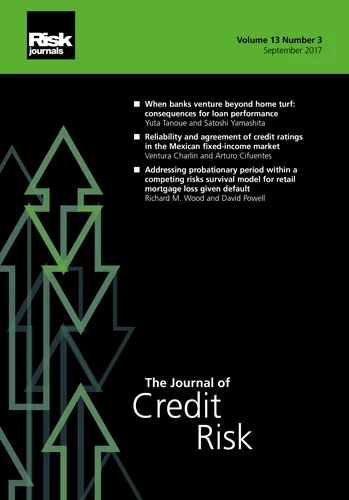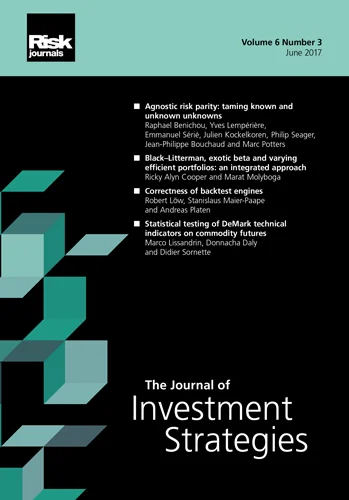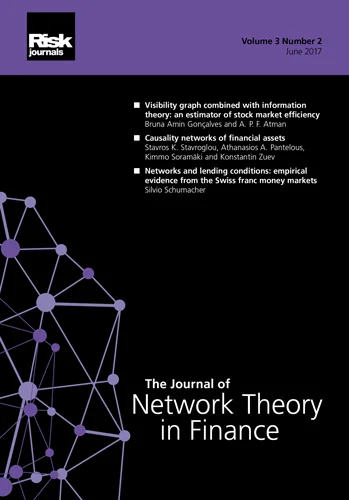Journal of Credit Risk
ISSN:
1755-9723 (online)
Editor-in-chief: Linda Allen and Jens Hilscher
IRMC 10th anniversary special issue (December 2018)
Editor's Letter
We are pleased to work with The Journal of Credit Risk on this important commemorative compendium of papers, which helps to highlight the International Risk Management Conference’s tenth anniversary. The papers were selected from a group of presentations at the June 12–14, 2017 conference in Florence, Italy, which was also the annual session’s birthplace in 2008. The papers represent the conference’s theme on “Bank Stability in a Challenging Economic and Financial Environment”, as well as celebrating the fiftieth anniversary of the introduction of Altman’s Z-score model in 1968 and its continuing applications in financial and managerial markets, especially its use by banks in calculating their capital charges based on the default risk of their counterparties. In all, there are four papers published in this special issue.
The first captures not only a fifty-year retrospective on Edward I. Altman’s Z-score model and its evolutionary development, extensions and applications, but also the reasons why the model has survived, indeed prospered, as can be seen from the thousands of other papers that cite the original article and discuss and compare corporate distress prediction models for numerous different reasons. Most banks today use Z-score type models to answer the regulatory challenge of establishing sufficient capital standards, hopefully guaranteeing their survival during a financial crisis. The reasons given for the Z-score model having survived over the fifty years since its inception are (1) that it is simple to understand and, importantly, for others to replicate and compare with newer and, in many cases, more powerful statistical, mathematical, artificial intelligence and machine-learning models; and (2) that it has continuing high statistical accuracy in correctly classifying companies as being likely to fail (type I), although it is less accurate in terms of predicting those that are not likely to fail (type II). Altman suggests that firms have, in general, become far more risky over the last half a century, and he thinks that his orig- inal guidelines for failure prediction require periodic adjustments to reflect a financial environment that both has far more leverage in its system than it did in earlier years, and, in most but not all years, contains far more bank and nonbank sources of capital and financial mechanisms (such as distressed exchanges and bailouts) to avoid a firm going bankrupt. The latter theory is also of great relevance to banking institutions.
Finally, Altman provides a rich compendium of possible applications of his distressed prediction models based on users who are (1) “external” to the firm being analyzed or (2) “internal” to the firm, either by its own management or by its board of directors, advisors, etc. This compendium of ideas was gleaned from both the author’s experience and from the many practitioners and scholars who have used the models over time.
The issue’s second paper, “Calculating capital charges for sector concentration risk” by Cornelius Kurtz, Eva Lutkebohmert and Julian Sester, also involves bank capital charges, but it concentrates on sector concentrations and risk assessment. The authors propose a methodology using the Merton multifactor framework to quantify capital charges based, in part, on the banks’ sector concentrations. The capital charge is based both on the individual asset’s risk and also, importantly, on the impact of the sector concentration on the possible portfolio losses. The authors’ Monte Carlo simulation approach to the possible portfolio risk dimensions is particularly applicable to financial institutions that themselves perform simulations in assessing the full spectrum of possible economic capital outcomes. The authors also present a second approach to capital charge estimation using a “tractable” analytical formula instead of a full-blown simulation, but they claim that this provides a more efficient approximation for economic capital than the more complex and expensive simulation. The results are particularly applicable for banks’ sector concentration risk capital allocations under Pillar 2 of the Basel regulatory framework. A key aspect of the authors’ approach to computing capital charges for concentration risk is that they define the sector effect as the impact of the weighting of different sector losses on the shape of the overall portfolio loss curve. The authors’ creative solution is accomplished by not allowing the sector effect to contribute to the portfolio loss distribution, thereby eliminating all nonlinear concentration effects, and then calculating the sector concentration charge as the difference between the original value-at-risk contribution and that of the sector, following the removal of the nonlinear concentration effects.
The third paper in our special issue is “Bank risk, bank bailouts and sovereign capacity during a financial crisis: a cross-country analysis” by Rafael F. Schiozer, Frederico A. Mourad and Ramon S. Vilarins. It concerns the important issue of bank bailouts related to the sovereign’s capacity to do so during a financial crisis. Specifically, the authors analyze the competitive effects of expectations of a bank bailout on the level of risk taken by a sample of banks in Organisation for Economic Co-operation and Development (OECD) countries. Ordinarily, the expectation that a bank will be bailed out increases the risk for that bank’s competitors. But during a crisis, the interesting argument presented in this paper is that these competitive effects are mitigated because banks with more protected competitors reduce their risk compared with banks with less protected competitors. This comparison is done via a cross-country analysis within the OECD, over a period that includes the global financial crisis period of 2008–9. The authors also show that for countries with greater sovereign default risk, the effect of the protection of competitors on bank risk during a crisis is smaller. That is, bailing out protected banks becomes less likely in these periods. Due to pressure on bank margins, expectations of a bailout lead to more risky tendencies during normal times, whereas market-disciplining forces become stronger for banks with protected creditors during a crisis, which in turn forces these banks to reduce risks. It is emphasized that the sample period 2005–15 is important because it includes normal as well as crisis periods for observation.
One of the main conclusions of this paper is that in “normal” times an increase in the protection of competitors distorts competition, reduces profit margins and increases risk taking. According to the analysis, the opposite is true during a crisis period due to market discipline. This, in turn, induces banks’ depositors to flee to more protected banks during a crisis – a fairly obvious observation – but now for the first time we also observe that unprotected banks react as well, by reducing risky lending even more than larger, more protected, banks do.
The final paper in our special issue, by Nobel Prize winner Robert Engle and Cristiano Zazzara, relates to systemic risk. In “Systemic risk in the financial system: capital shortfalls under Brexit, the US elections and the Italian referendum”, the authors attack the critical issue of adequate capital during a financial crisis via a sophisticated, yet easy to understand, econometric model to measure all major bank potential capital shortfalls given certain market conditions. The quantitative indicator used in this analysis – developed by the Volatility Laboratory at NYU Stern School of Business – is known as SRISK: a model widely used by market practitioners, scholars and regulators. SRISK is similar to bank stress tests, but it is based exclusively on publicly available information, ie, market and bank accounting data. The systemic risk element is that banks with a high capital shortfall in a crisis are the institutions with potential to exacerbate the crisis and extend it to the general economy.
The authors use their SRISK test to estimate the capital shortfalls of banks and other financial institutions, eg, insurance firms, under three important stress events: the Brexit referendum, the election of Donald Trump as US president and the Italian referendum, all of which took place in 2016. The authors refer to these events collectively as BRUMPIT! The results of the first two stress events – Brexit and the election of Trump – showed a material, but temporary, increase in aggregate systemic risk. More importantly, the SRISK model added clarity to the “contributions” of specific financial institutions to selected stress events. The results show quite clearly that the effects of the three events did not appear to persist over the event window, showing that financial institutions are significantly resilient to those shocks. The authors conclude that their quantitative measure of systemic risk applied to specific events demonstrates the dynamic and forward-looking nature of the metric, which can therefore contribute to the transparency surrounding systemic risk measures.
Edward I. Altman
Max L. Heine Professor of Finance, Emeritus, NYU Stern School of Business
Herbert Rijken
Professor of Finance, Vrije University of Amsterdam
Papers in this issue
A fifty-year retrospective on credit risk models, the Altman Z-score family of models and their applications to financial markets and managerial strategies
This paper reflects upon the evolution of the Altman family of bankruptcy prediction models, as well as their extensions and multiple applications in financial markets and managerial decision making.
Calculating capital charges for sector concentration risk
This paper proposes a methodology to quantify capital charges for concentration risk when economic capital calculations are conducted within a multifactor Merton framework.
Bank risk, bank bailouts and sovereign capacity during a financial crisis: a cross-country analysis
This paper analyzes the competitive effects of government bailout expectations on bank risk using a sample of banks in OECD countries from 2005 to 2015.
Systemic risk in the financial system: capital shortfalls under Brexit, the US elections and the Italian referendum
This paper uses SRISK to quantify the estimated capital shortfalls of financial institutions under three relevant stress events that occurred in 2016: Brexit, the Trump election and the Italian referendum.








